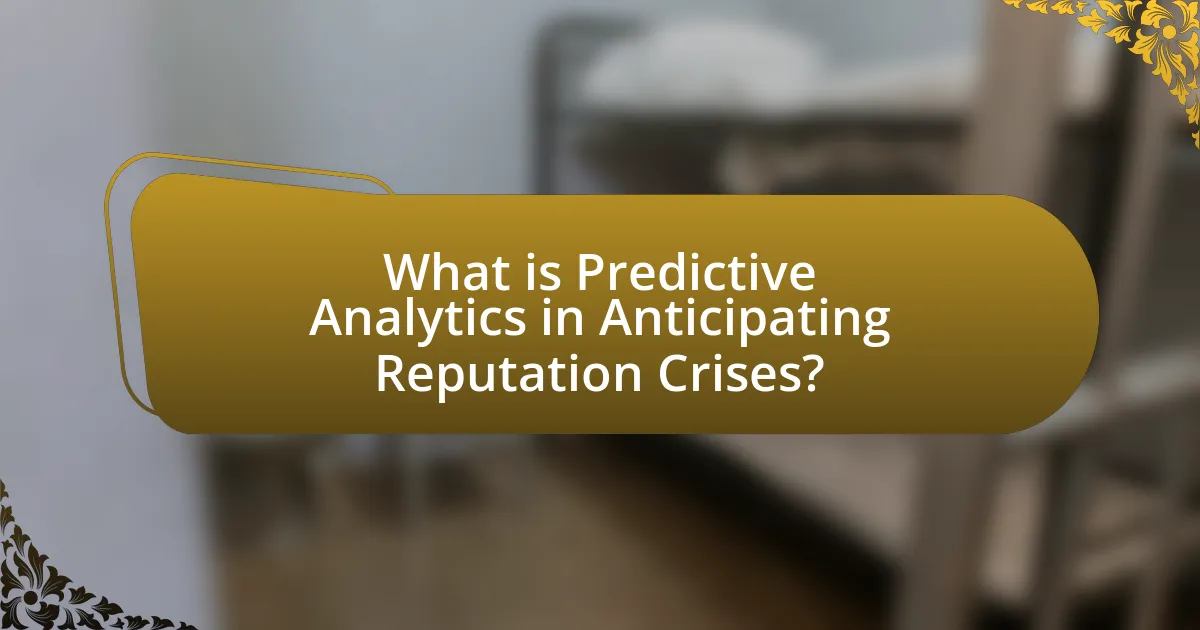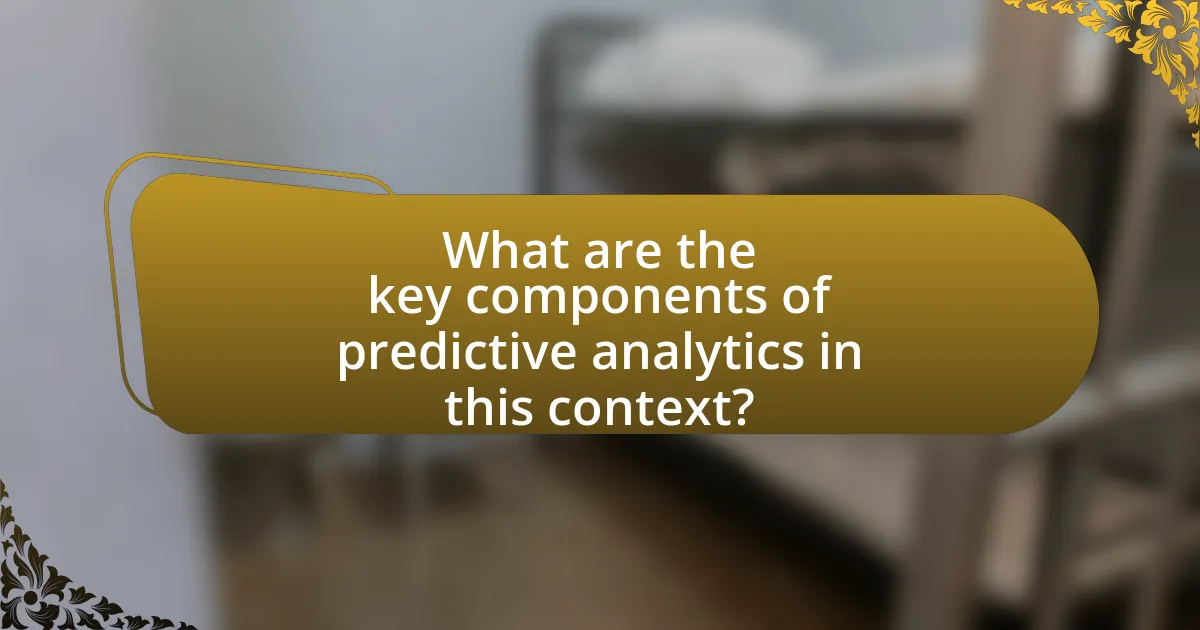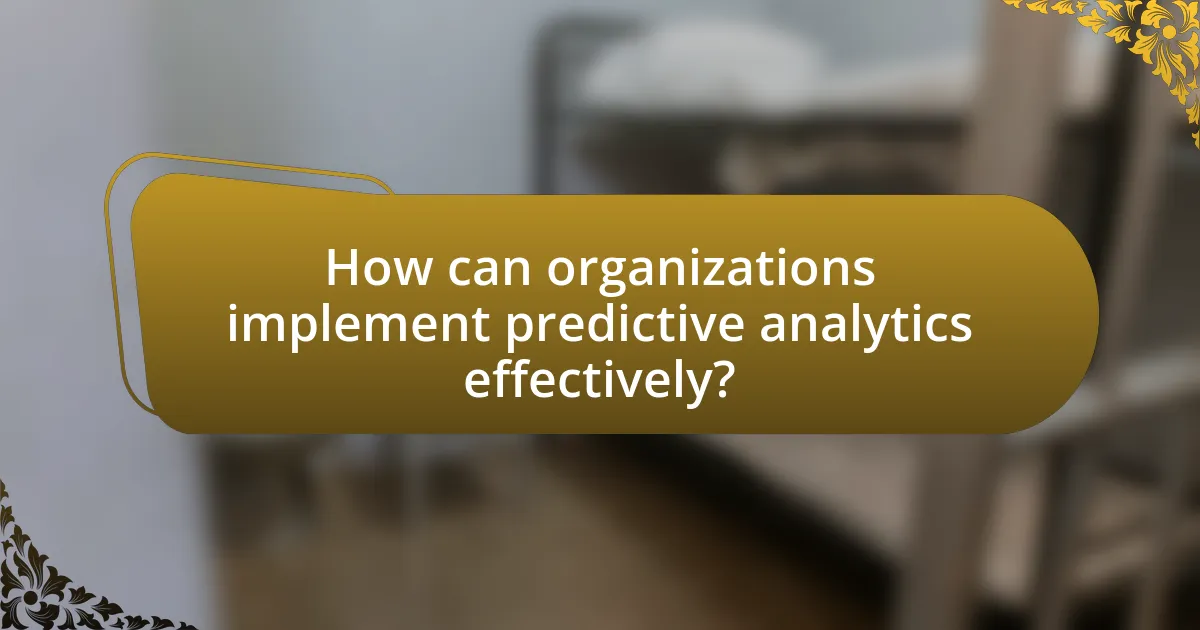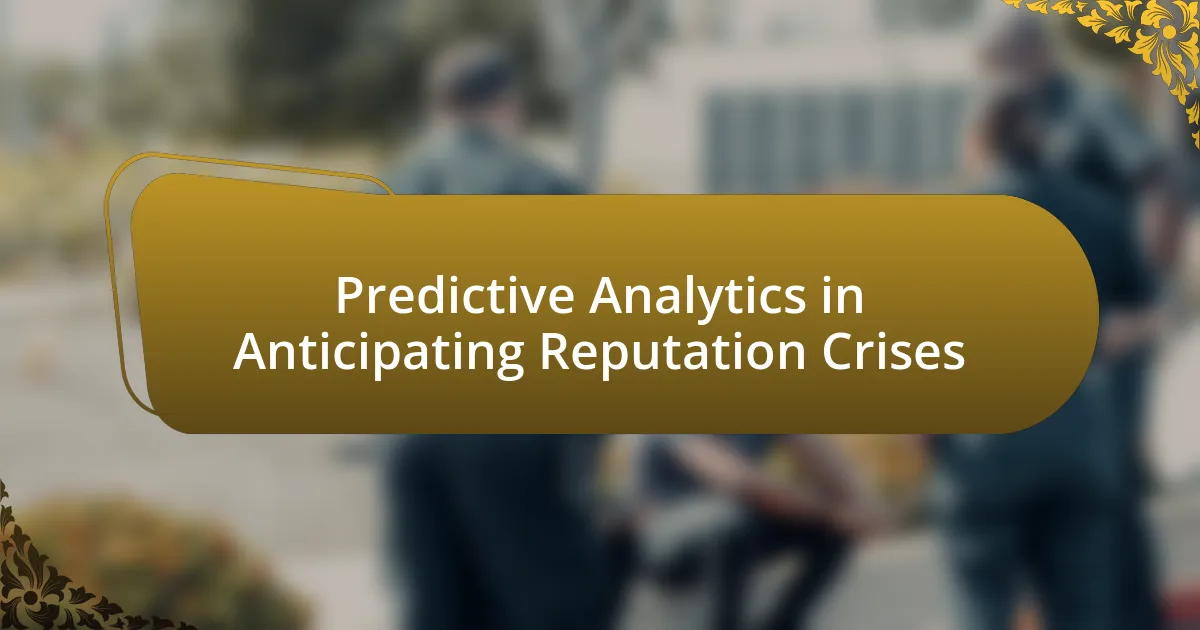Predictive analytics is a data-driven approach used to anticipate reputation crises within organizations by analyzing historical data, social media trends, and customer feedback. This article explores how predictive analytics contributes to effective reputation management, detailing the data sources utilized, techniques for forecasting potential issues, and the importance of early detection in mitigating the impacts of reputation crises. Key components such as data collection, analysis, and monitoring are discussed, along with the challenges organizations face in implementing predictive analytics and best practices for continuous improvement. The article emphasizes the significance of collaboration between data teams and reputation managers to enhance decision-making and maintain a positive public image.

What is Predictive Analytics in Anticipating Reputation Crises?
Predictive analytics in anticipating reputation crises involves the use of data analysis techniques to forecast potential threats to an organization’s reputation before they occur. This approach utilizes historical data, social media monitoring, and sentiment analysis to identify patterns and signals that may indicate an emerging crisis. For instance, a study by the Harvard Business Review highlights that companies employing predictive analytics can reduce the impact of reputation crises by up to 30% by proactively addressing issues identified through data trends.
How does predictive analytics contribute to reputation management?
Predictive analytics contributes to reputation management by enabling organizations to anticipate potential reputation crises before they escalate. By analyzing historical data, social media trends, and customer feedback, predictive analytics identifies patterns and signals that may indicate emerging issues. For instance, a study by McKinsey & Company found that companies using predictive analytics can reduce the risk of reputation damage by up to 30% through timely interventions. This proactive approach allows businesses to address concerns swiftly, thereby maintaining a positive public image and fostering customer trust.
What data sources are utilized in predictive analytics for reputation crises?
Predictive analytics for reputation crises utilizes various data sources, including social media platforms, online reviews, news articles, and customer feedback. Social media platforms provide real-time sentiment analysis, allowing organizations to gauge public perception and identify potential issues early. Online reviews contribute to understanding customer experiences and can highlight emerging trends that may lead to a reputation crisis. News articles serve as a critical source for tracking media coverage and public discourse surrounding a brand, while customer feedback offers direct insights into consumer concerns and expectations. Collectively, these data sources enable organizations to proactively manage their reputation by identifying risks and responding to potential crises before they escalate.
How is data analyzed to forecast potential reputation issues?
Data is analyzed to forecast potential reputation issues through techniques such as sentiment analysis, trend analysis, and social media monitoring. Sentiment analysis evaluates public opinion by processing large volumes of text data from online sources, identifying positive, negative, or neutral sentiments associated with a brand. Trend analysis examines patterns over time, allowing organizations to detect emerging issues before they escalate. Social media monitoring tracks mentions and discussions about a brand across various platforms, providing real-time insights into public perception. These methods collectively enable organizations to identify early warning signs of reputation crises, allowing for proactive management and response strategies.
Why is anticipating reputation crises important for organizations?
Anticipating reputation crises is crucial for organizations because it enables proactive management of potential threats to their public image. By identifying risks early, organizations can implement strategies to mitigate damage, maintain stakeholder trust, and protect their market position. Research indicates that companies that effectively manage reputation crises can recover their stock prices more quickly; for instance, a study by the Harvard Business Review found that firms with strong crisis management plans can reduce the financial impact of a crisis by up to 50%. This underscores the importance of predictive analytics in recognizing patterns and signals that may indicate an impending crisis, allowing organizations to act decisively and maintain their reputation.
What are the potential impacts of reputation crises on businesses?
Reputation crises can severely impact businesses by leading to decreased customer trust, financial losses, and long-term brand damage. When a company’s reputation is compromised, studies show that customer loyalty can drop significantly, with 60% of consumers stating they would stop purchasing from a brand after a scandal. Financially, businesses may experience a decline in stock prices; for instance, a 2018 study found that companies facing reputation crises saw an average stock price drop of 30%. Additionally, the long-term effects can include increased difficulty in attracting talent and higher costs for marketing and public relations efforts to rebuild trust.
How can early detection mitigate the effects of reputation crises?
Early detection can significantly mitigate the effects of reputation crises by enabling organizations to respond proactively rather than reactively. When potential issues are identified early through predictive analytics, companies can implement corrective measures before the situation escalates, thereby preserving their public image. For instance, a study by the Harvard Business Review found that companies that addressed negative customer feedback within 24 hours saw a 33% increase in customer satisfaction compared to those that delayed their response. This demonstrates that timely intervention can not only reduce the severity of a crisis but also enhance stakeholder trust and loyalty.

What are the key components of predictive analytics in this context?
The key components of predictive analytics in the context of anticipating reputation crises include data collection, data analysis, predictive modeling, and monitoring. Data collection involves gathering relevant information from various sources, such as social media, customer feedback, and market trends. Data analysis entails examining this information to identify patterns and correlations that may indicate potential reputation issues. Predictive modeling uses statistical techniques to forecast future events based on historical data, allowing organizations to anticipate crises before they escalate. Finally, monitoring involves continuously tracking relevant metrics and signals to detect early warning signs of a reputation crisis, enabling timely intervention. These components work together to provide organizations with actionable insights to manage and mitigate reputation risks effectively.
What techniques are commonly used in predictive analytics?
Common techniques used in predictive analytics include regression analysis, decision trees, neural networks, and time series analysis. Regression analysis helps in understanding relationships between variables and predicting outcomes based on historical data. Decision trees provide a visual representation of decision-making processes, allowing for easy interpretation of complex data. Neural networks, inspired by the human brain, excel in identifying patterns in large datasets, making them suitable for complex predictive tasks. Time series analysis focuses on analyzing data points collected or recorded at specific time intervals, enabling forecasts based on temporal trends. These techniques are widely adopted across industries to enhance decision-making and anticipate potential reputation crises effectively.
How do machine learning algorithms enhance predictive capabilities?
Machine learning algorithms enhance predictive capabilities by analyzing vast amounts of data to identify patterns and trends that human analysts may overlook. These algorithms utilize techniques such as regression analysis, decision trees, and neural networks to make accurate predictions based on historical data. For instance, a study by Google Research demonstrated that machine learning models could improve forecasting accuracy by up to 30% compared to traditional statistical methods. This increased accuracy allows organizations to anticipate reputation crises more effectively, enabling proactive measures to mitigate potential damage.
What role does sentiment analysis play in reputation crisis prediction?
Sentiment analysis plays a crucial role in predicting reputation crises by analyzing public sentiment towards a brand or organization. This analytical approach enables businesses to identify negative trends in consumer opinions and emotions, which can signal potential crises before they escalate. For instance, a study by Liu et al. (2019) demonstrated that monitoring social media sentiment can provide early warnings of reputational damage, allowing companies to implement proactive measures. By quantifying sentiment through natural language processing techniques, organizations can effectively gauge public perception and respond to emerging issues, thereby mitigating the impact of potential reputation crises.
What metrics are essential for measuring reputation risk?
Essential metrics for measuring reputation risk include sentiment analysis scores, brand equity metrics, social media engagement rates, and customer satisfaction indices. Sentiment analysis scores quantify public perception by analyzing online mentions and reviews, providing insights into positive or negative sentiments associated with a brand. Brand equity metrics assess the value of a brand based on consumer perception, loyalty, and market position, which directly correlates with reputation. Social media engagement rates reflect how audiences interact with a brand’s content, indicating potential reputation issues through declining engagement. Customer satisfaction indices measure consumer satisfaction levels, which can signal reputation risks if scores drop significantly. These metrics collectively offer a comprehensive view of a brand’s reputation health and potential risks.
How can organizations quantify their reputation health?
Organizations can quantify their reputation health by utilizing metrics such as Net Promoter Score (NPS), sentiment analysis from social media, and brand equity assessments. NPS measures customer loyalty and satisfaction, providing a numerical value that reflects overall reputation. Sentiment analysis employs natural language processing to evaluate public perception by analyzing online conversations, reviews, and comments, thus offering insights into positive or negative sentiments associated with the brand. Brand equity assessments involve evaluating the financial value of a brand based on consumer perception, market share, and competitive positioning. These methods collectively provide a comprehensive view of an organization’s reputation health, enabling proactive management of potential reputation crises.
What indicators signal a potential reputation crisis?
Indicators that signal a potential reputation crisis include a sudden increase in negative social media mentions, a rise in customer complaints, and a decline in customer satisfaction ratings. For instance, a study by the Pew Research Center found that 70% of consumers are influenced by online reviews, indicating that a spike in negative feedback can significantly impact public perception. Additionally, monitoring sentiment analysis tools can reveal shifts in public opinion, with a notable drop in positive sentiment often preceding a crisis. These indicators serve as early warning signs that organizations should address to mitigate potential damage to their reputation.

How can organizations implement predictive analytics effectively?
Organizations can implement predictive analytics effectively by establishing a clear strategy that integrates data collection, analysis, and actionable insights into their decision-making processes. This involves identifying key performance indicators relevant to reputation management, utilizing advanced analytics tools to process large datasets, and employing machine learning algorithms to forecast potential reputation crises based on historical data and trends. For instance, a study by McKinsey & Company found that organizations leveraging predictive analytics can improve their decision-making speed by 5 to 10 times, thereby enhancing their ability to respond proactively to emerging issues. Additionally, continuous monitoring and refinement of predictive models ensure that organizations remain agile and responsive to changes in public sentiment and market dynamics.
What steps should organizations take to integrate predictive analytics?
Organizations should take the following steps to integrate predictive analytics: first, they must define clear objectives for predictive analytics that align with their business goals. This involves identifying specific problems or opportunities where predictive insights can add value, such as anticipating reputation crises. Next, organizations should gather and prepare relevant data from various sources, ensuring data quality and consistency, as accurate data is crucial for effective predictive modeling.
Following data preparation, organizations need to select appropriate predictive analytics tools and technologies that fit their needs, which may include machine learning algorithms and statistical software. After selecting tools, they should build and validate predictive models using historical data to ensure reliability and accuracy in forecasting potential reputation issues.
Finally, organizations must implement a continuous monitoring system to track the performance of predictive models and adjust strategies based on real-time insights. This iterative process allows organizations to refine their predictive capabilities and respond proactively to emerging reputation crises.
How can organizations build a data-driven culture for reputation management?
Organizations can build a data-driven culture for reputation management by integrating data analytics into decision-making processes and fostering a mindset that values data insights. This involves training employees on data interpretation, utilizing advanced analytics tools to monitor public sentiment, and establishing clear metrics for reputation assessment. For instance, a study by McKinsey found that companies leveraging data analytics can improve their decision-making speed by 5 to 10 times, which directly impacts their ability to respond to reputation crises effectively. By prioritizing data literacy and employing predictive analytics, organizations can proactively identify potential reputation risks and address them before they escalate.
What tools and technologies are available for predictive analytics?
Predictive analytics utilizes various tools and technologies to analyze data and forecast future trends. Key tools include statistical software like R and Python, which offer libraries such as scikit-learn and TensorFlow for machine learning. Additionally, platforms like SAS, IBM SPSS, and Microsoft Azure provide comprehensive analytics solutions. Cloud-based services such as Google Cloud AI and Amazon Web Services also support predictive modeling through scalable infrastructure and advanced algorithms. These tools are widely adopted in industries for their ability to process large datasets and generate actionable insights, thereby enhancing decision-making processes.
What challenges might organizations face in using predictive analytics?
Organizations may face several challenges in using predictive analytics, including data quality issues, lack of skilled personnel, and resistance to change. Data quality issues arise when organizations have incomplete, inaccurate, or inconsistent data, which can lead to unreliable predictions. According to a study by Gartner, poor data quality costs organizations an average of $15 million per year. Additionally, the lack of skilled personnel, such as data scientists and analysts, can hinder the effective implementation of predictive analytics, as organizations may struggle to interpret complex data models. Furthermore, resistance to change from employees and management can impede the adoption of predictive analytics, as stakeholders may be hesitant to trust data-driven insights over traditional decision-making processes. These challenges collectively impact the effectiveness of predictive analytics in anticipating reputation crises.
How can data privacy concerns impact predictive analytics efforts?
Data privacy concerns can significantly hinder predictive analytics efforts by limiting the availability and quality of data. When organizations prioritize data privacy, they may restrict data collection practices or anonymize datasets, which can reduce the granularity and accuracy of insights derived from predictive models. For instance, regulations like the General Data Protection Regulation (GDPR) impose strict guidelines on data usage, compelling companies to implement consent mechanisms that can lead to incomplete datasets. According to a study by McKinsey, organizations that fail to address data privacy effectively may experience a 30% decrease in the effectiveness of their predictive analytics initiatives due to insufficient data quality and quantity.
What are common pitfalls in interpreting predictive analytics results?
Common pitfalls in interpreting predictive analytics results include over-reliance on data without context, misinterpretation of correlation as causation, and neglecting the quality of the data used. Over-reliance on data can lead to decisions based solely on numerical outputs, ignoring qualitative factors that may influence outcomes. Misinterpreting correlation as causation can result in erroneous conclusions, as two variables may appear related without one causing the other. Additionally, neglecting data quality can introduce biases and inaccuracies, undermining the reliability of the analytics. For instance, a study by the Harvard Business Review highlights that poor data quality can lead to a 20% loss in productivity, emphasizing the importance of accurate data in predictive analytics.
What best practices should organizations follow for effective predictive analytics?
Organizations should follow best practices such as defining clear objectives, ensuring data quality, and employing advanced analytical techniques for effective predictive analytics. Clear objectives guide the analytics process, allowing organizations to focus on relevant metrics and outcomes. High-quality data is essential, as inaccuracies can lead to misleading predictions; a study by IBM found that poor data quality costs organizations an average of $15 million annually. Advanced analytical techniques, including machine learning and statistical modeling, enhance predictive capabilities, enabling organizations to identify patterns and trends that inform decision-making.
How can organizations continuously improve their predictive models?
Organizations can continuously improve their predictive models by implementing iterative model evaluation and refinement processes. This involves regularly assessing model performance using metrics such as accuracy, precision, and recall, and adjusting algorithms or features based on the insights gained. For instance, organizations can utilize techniques like cross-validation to ensure robustness and avoid overfitting, which enhances the reliability of predictions. Additionally, incorporating new data sources and updating the training datasets can significantly enhance model performance, as evidenced by studies showing that models trained on diverse datasets yield better generalization. Continuous monitoring and feedback loops from real-world outcomes also facilitate timely adjustments, ensuring that predictive models remain relevant and effective in anticipating reputation crises.
What strategies can enhance collaboration between data teams and reputation managers?
Enhancing collaboration between data teams and reputation managers can be achieved through regular communication, shared goals, and integrated tools. Regular communication ensures that both teams are aligned on objectives and can quickly address emerging issues. Establishing shared goals, such as improving brand sentiment or reducing response time to crises, fosters a unified approach to reputation management. Utilizing integrated tools, like dashboards that combine data analytics with reputation metrics, allows both teams to access real-time insights and collaborate effectively. These strategies are supported by studies showing that organizations with cross-functional collaboration experience 30% higher productivity and 25% faster project completion rates.

Leave a Reply